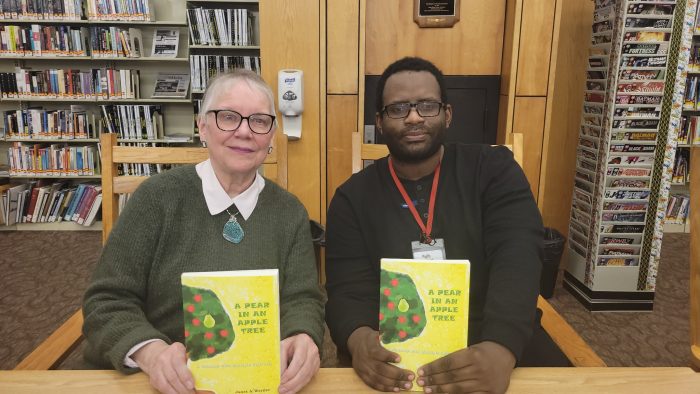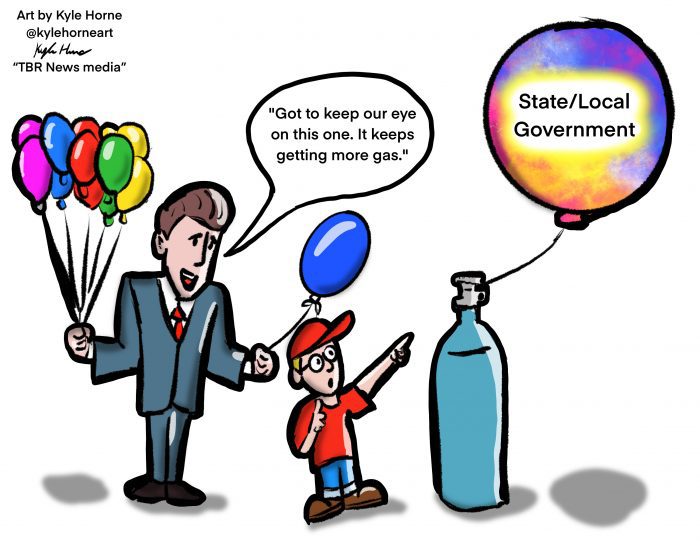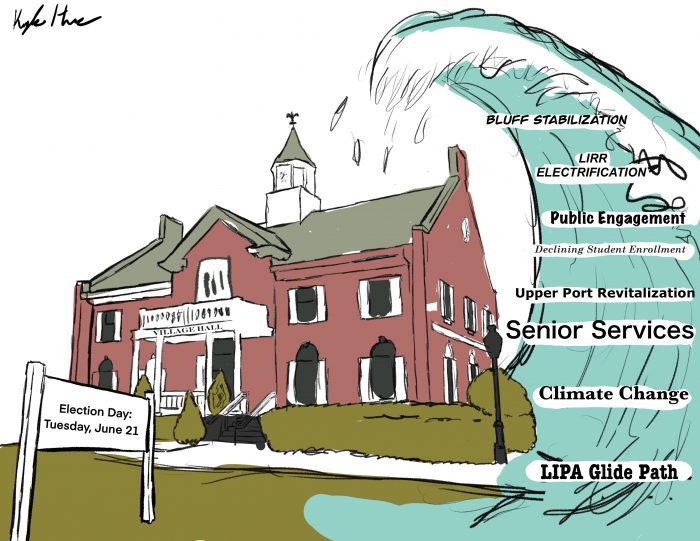
Kyle Horne
TBR News Media wins 11 state press awards

By Heidi Sutton
From news articles and feature stories to photography, special supplements, ad projects and classifieds, TBR News Media took home 11 awards from the New York Press Association’s Better Newspaper Contest this year. The winners were announced during NYPA’s annual Spring Conference and Trade Show in Albany on March 31 and April 1.
Over 150 newspapers in New York State took part in the annual event celebrating newspaper excellence with 2,657 entries competing for 380 awards in 73 categories covering the editorial, advertising and circulation efforts of the state’s dailies and weeklies. Members of the Colorado Press Association were tasked with judging this year’s contest.
 “Newspapers create a brand-new product on a daily or weekly basis, 52 weeks a year,” said New York Press Association Executive Director Michelle Rea in a press release. “They work on tight deadlines with small staffs, covering local government, breaking news, sports, business, entertainment, and more. Receiving recognition from their peers in another state is affirming and energizing. We salute them for the top quality, important work they do.”
“Newspapers create a brand-new product on a daily or weekly basis, 52 weeks a year,” said New York Press Association Executive Director Michelle Rea in a press release. “They work on tight deadlines with small staffs, covering local government, breaking news, sports, business, entertainment, and more. Receiving recognition from their peers in another state is affirming and energizing. We salute them for the top quality, important work they do.”
TBR News Media’s weekly opinion piece, D. None of the Above by Daniel Dunaief, captured first place for Best Column. In reviewing the three submissions — “The complexities of plural nouns and words for animal groups,” “From Suffolk, UK, to Suffolk, NY, a family reflects on the late queen,” and “Seeing teachers through the eyes of an appreciative child” — the judge wrote, “Imaginative and compelling. Fun storytelling that makes for an easy read.”
Editor Raymond Janis won second place in the Coverage of Local Government category. Regarding his submissions of the articles “Uptown Port Jeff undergoes transformation” and “On the edge: Port Jeff Village weighs the fate of its country club,” the judge commented, “This reporter delves deep into a complicated story about a town landmark and development pressures and how a community can approach preserving a delicate area in the face of continued deterioration. Nicely written, well-sourced and clearly a story that is of deep interest to this community. This kind of coverage is the hallmark of strong local reporting.”
Janis also received an Honorable Mention in the Best News or Feature Series category for covering the Town of Brookhaven’s redistricting process.
TBR News Media was honored with second place in the Best Local Business Support Campaign category for its annual People of the Year feature which honors community members who have shared their time and talents to enhance the place they live for the benefit of all. “Nice program,” wrote the judge. “Shows involvement in the community. And involves the community.”
Managing editor Rita J. Egan received an Honorable Mention in the Best Feature Story category for her article titled “Town to move Roe Tavern back to North Country Road in East Setauket.” The judge wrote, “I like the way this combined current and historic information.”

The paper’s resident cartoonist Kyle Horne also received an Honorable Mention in the Best Editorial Cartoon category for an illustration related to the Town of Brookhaven’s redistricting process with the judge commenting, “I like the local angle this takes, even though it could be a cartoon drawn for any place in the country, following redistricting.”
Photographer Steven Zaitz won second place in the Best Picture Story category for his coverage of the Town of Smithtown’s Memorial Day Parade. “Good variety of parade photos. Clear photos, good composition and lots of expression!” wrote the judge.

TBR News Media’s annual supplement Harvest Times by editor Heidi Sutton received two third place awards — one for Best Special Section Cover and another for Best Special Sections/Niche Publications in Newsprint — with the judge commenting, “Love the entire fall theme, from festivals, farms to seasonal soup and pie recipes. Creative use of color. Layout is very readable.”
Art/Production Director Beth Heller Mason received an Honorable Mention for Best Small Space Ad for the design of the Pazzo Ristorante and Wood Fired Pizza ad in TBR’s Arts & Eats supplement. “The flames and brick in the background tell you that this is brick oven pizza without ever saying it in words. The ad tells me this is no ordinary pizza!” wrote the judge.
Rounding out the awards, Classifieds Director Sheila Murray won second place in the Classified Advertising category. “I like the way the designer used different line weights to separate sections. Also, the use of white space above and below the line ads makes the pages not feel so cluttered and makes it easier to read the ads. Sometimes designing in black and white can be challenging, but this layout is an example of how to do it right. This was very close between first and second places,” wrote the judge.
“I’m tremendously proud of our staff and grateful for their commitment to excellent journalism. I’m delighted that the awards represent the breadth of our talent, from writing to advertising to art,” said TBR News Media publisher Leah Dunaief. “In addition to it being our job, it is our pleasure to serve our communities.” For a full list of winners, visit nynewspapers.com/nypa.
Teacher-pupil pair inspire hope for those with multiple sclerosis

One of TBR News Media’s very own recently embarked on a life-changing collaboration with a former educator.
Kyle Horne, a local artist and frequent contributor of political cartoons and editorial illustrations to our newspapers, has partnered with his former teacher, Janet Werner, to create a book about multiple sclerosis. Together, they tell a moving story of overcoming adversity, revealing a powerful, enduring bond between a student and teacher.
A journey with MS
Werner was diagnosed with multiple sclerosis, commonly known as MS, in 1986. At the onset of her symptoms, she recalled a feeling of numbness in her legs and overwhelming fatigue.
“I actually took off for two weeks from work that first year and just slept,” she said. “I got an MRI at the time, and it showed plaque in the brain, which is white lesions. Depending upon where these white lesions are seen in the brain, it could affect your mobility, cognition and eyesight.”
As the years advanced, Werner’s symptoms gradually progressed. During a startling incident one morning, she temporarily lost her eyesight and hearing completely. “What seemed like hours was about 20 minutes,” she said. “I was terrified because it had never happened before.”
Nearly four decades after her initial diagnosis, Werner explained she is “doing pretty well” despite the heightening symptoms with each passing year. She said managing the symptoms requires plenty of rest and an upbeat mentality.
With husband Ernest, “we try to get some exercise, eat correctly and just keep a positive frame of mind,” she said. “Of course, life is very stressful but we try to be positive.”
‘A Pear in an Apple Tree’
Over several years, Werner wrote “A Pear in an Apple Tree: A Journey with Multiple Sclerosis,” saying she was motivated to write the book for various reasons.
Among them, she noted a lack of public understanding surrounding MS and its symptoms. She also wanted to share her story with those experiencing MS, preparing them for the path ahead and informing them that they are not alone.
“Sometimes with any challenge in your life, you feel like you’re the only one who has this specific condition or challenge, whether it’s MS or cancer and you kind of hide away from the rest of the world,” she said. “That’s not good to do that. I wanted the ‘MSers’ to feel that we’re in this together.”
Werner recalled the moment that gave the book its name. She said she was eating dinner with her husband, struggling with her symptoms that day, when she blurted out, “I feel like a pear in an apple tree, kind of out of place.”
Despite the numerous challenges through the years, Werner said she wrote the book to let others know they have a place with an MS community that also understands their struggles.
A dynamic team
The collaboration between Werner and Horne has been decades in the making. A graduate of Deer Park High School, Horne was her student and a member of the school’s Students Against Destructive Decisions Club, which Werner had advised.‘You have to educate yourself about the disease and how it affects your body. And then learn to adapt.’
— Janet Werner
“He would invite me to some of his book signings and art shows, and we kept in close contact over the years,” she said. “When I was doing this book, I immediately thought of him because I loved his artwork.”
Horne described the early stages of preparing the book with his former teacher. He was eager to sign onto the project.
“She came to me with this idea for a book dealing with MS and how it affects her,” Horne said. Although managing symptoms “can be difficult, those challenges have been very helpful in developing her into the person she is today.”
Along with the cover and back cover, Horne prepared several illustrations throughout the book, tying into the themes of each of its chapters. Together, Werner and Horne developed the characters of Ned and Nancy Neuron.
Through the illustrations he prepared for the book, Horne said he learned much about Werner and her experiences with MS, describing a sense of growth and mutual understanding forged throughout their creative journey together.
“I don’t have MS, but I’m able to sympathize more with Janet and the struggles that she’s had,” the artist said. “She has a very strong spirit when it comes to this.”
An optimistic future
Following the success of their first collaboration, Werner and Horne are already working on the next project, a coloring book that adds an interactive component to the story of Ned and Nancy Neuron.
Werner said she remains “very hopeful” that researchers will soon discover a cure for MS. Analyzing the scope of scientific investigation into the condition, she said there is considerable overlap between ongoing MS research and similar autoimmune diseases.
“Research that’s being conducted for, say, AIDS or lupus is also being conducted for MS,” she said. “Stony Brook [University] has an MS center, and their research is going on at a rapid rate. So I am so hopeful.”
Despite the decades she has spent with MS, Werner shares a message of resolve in the face of hardship.
“I think you have to keep fighting,” she said. “You cannot give up. If you’re faced with a challenge, you have to educate yourself about the disease and how it affects your body. And then learn to adapt.”
Horne said the collaboration with Werner has been a personal experience as well. Learning about MS, he said, has informed his outlook on his own life.
“I have a condition known as ulcerative colitis, also known as Crohn’s disease,” Horne said. “Understanding the perspective of another chronic illness, and from a different person, has come to help with my own process and working through my own things.”
He added, “When it comes to something like this it can be very scary at times, but it also can be very rewarding knowing the perseverance of getting through a struggle like that.”
To learn more about MS, visit www.nationalmssociety.org. To purchase “A Pear in an Apple Tree,” visit www.allbook-books.com.
Editorial: For local elections, put principle over party

It is shaping up to be a big election season for the residents of Suffolk County. It may be early in 2023, but we’re already thinking about Election Day. County Executive Steve Bellone (D) is termed out, triggering massive turnover across levels of local government.
As local Democratic and Republican committees put forward their slate of candidates for county executive, town supervisor and various legislative positions, it is time for We the People to do our homework.
County, town and village officials have a different set of responsibilities than those serving on the state or federal levels. Their duties locally include making decisions about land use, law enforcement, roadwork, waste management, recreational facilities and matters that affect our everyday lives.
Preserving open space, treating our garbage and paving roads are not issues of Democrat versus Republican. These matters impact every resident, which is why it’s important to put aside party affiliation when we enter the voting booth this year.
Experience matters.
Before you vote, take a look at the candidates’ respective backgrounds. Does a candidate have relevant experience in the public or private sectors that will aid his or her decision making? Here at TBR News Media, we will take a deep dive into these candidates over the coming months, introducing our readers to their professional backgrounds and policy positions.
We know all the candidates will have much to say in the months ahead, and many will back their goals for our future with concrete plans.
As journalists, it is our job to provide our readers with the information necessary to make informed decisions on Election Day. We take this responsibility seriously and look forward to following these elections closely.
In the meantime, we remind our readers that you play a part in this as well. By writing letters to the editor about the various local races, you have the opportunity to interpret and contextualize our election coverage. Letters are your chance to influence the shape of our democracy, so don’t squander it.
Before voting, remember to research your ballot thoroughly, check your party affiliation at the door and keep an open mind. We will be here to help along the way.
Between You and Me: Last Licks of Summer
ON VACATION: Leah Dunaief’s column, Between You and Me, will return next week.
Editorial: In post-Roe America, locality is the mentality
“All politics is local.” This expression rings truer today than ever before.
The Framers of the U.S. Constitution envisioned a system of federalism for the United States — one in which the national government was assigned a select number of well-defined powers, with all other powers not delegated by the Constitution reserved to the states. Over the course of American history, however, more and more powers have been delegated to the federal government.
Right now, we are witnessing a turning point in a century-long power struggle between the federal government and the states. Democratic presidents such as Woodrow Wilson, Franklin Delano Roosevelt and Lyndon B. Johnson incrementally augmented the size of the federal government and expanded the scope of its powers. After a century of concentrating power in Washington, the U.S. Supreme Court is now undoing that legacy, returning decision-making authority to lower levels of government.
Two recent SCOTUS opinions have dramatically altered the balance of power in this country. The court ruled in Dobbs v. Jackson Women’s Health Organization that the Constitution does not confer a right to abortion. In New York State Rifle & Pistol Association Inc. v. Bruen, the court overruled New York State’s proper-cause licensing requirement for concealed carry of a handgun, making it harder for New York and other states to regulate concealed carry.
The one interconnecting theme of both of these decisions is that the federal government is yielding much of its power to the states, putting greater pressure on state and local governments to make decisions on behalf of the people.
No longer are the days of FDR, who saw the federal government as the vehicle to drive the national economy with his New Deal. No longer are the days of LBJ, whose Great Society program sought to eliminate poverty and racial disparities using the federal government as its engine. In this post-Roe America, the power of the federal government is waning, taken out of its hands and placed in the hands of the states.
There are some possible benefits to the decentralization of federal power. For starters, this may reduce voter polarization and division in the United States. With fewer decision-making powers, the stakes will be reduced for congressional and presidential elections. While national security and interstate commerce will always be the domain of the federal government, a host of domestic issues may soon return to the states, meaning state and local elections may soon carry much greater weight.
As power shifts away from the federal government and into our backyards, local residents must maintain an active interest in their state and local legislatures as these bodies will be deciding upon the issues that matter the most. Citizens can — and should — stay informed by reading their local newspapers, where information on these matters is most accessible. And they should remember to write letters to the editor because this remains a tried-and-true method to reach and persuade one’s fellow citizens.
Editorial: Suffolk OTB – Powering our democracy
A government is only as democratic as the freedom and fairness of its electoral process.
Right now, the legislative and executive branches of the Suffolk County government are at odds over what constitutes a free and fair election. At a press conference last week, County Executive Steve Bellone (D) defended a 2017 law that created a public campaign finance fund. He said this program, which is set to take effect during the 2023 county election cycle, will restore “the people’s faith and trust in government.”
At the same time, the Republican majority intends to repeal the law, arguing the program undermines trust in government as public funds will inevitably be used to finance campaigns that some voters do not endorse. Instead, it favors using that money to strengthen public safety initiatives around the county.
While the political branches battle it out, it is worth noting that this program is not supported by tax revenue. Rather, it is supported by revenues generated by Jake’s 58 Casino Hotel, which was acquired last year by Suffolk Regional Off-Track Betting. The question that no one has asked is how OTB factors into this equation.
For eons, societies have struggled to root out vice and promote virtue among their people. It seems a fact of human nature that we are created with various flaws and foibles. Gambling, boozing and prostitution are nasty habits that will be among us regardless of the system of government that we put in place.
Using gambling revenues to finance grassroots campaigns seems to be a noble end. This is not much different from a real estate developer contributing monetarily to a community to compensate for the potential losses incurred during the buildout. Attaching a just cause to an activity like gambling appears to be a worthwhile undertaking. Bellone himself said, “I can’t think of a better way that we can utilize those dollars.”
However, if we are going to stake our democracy and the integrity of our elections on this public campaign finance program, we must demand much greater transparency from the institution that will be supporting it, Suffolk OTB. As recently as March, a local activist referred to OTB as “a known patronage mill.”
There are still far too many questions yet to be answered by OTB. What percentage of its revenue will be used to finance elections? What is the leadership hierarchy? How many people are employed? What is the process for securing employment there? How does the power source of our democracy still not have an “about” page on its website?
It is a giant leap of faith on the part of voters to expect a gaming parlor to act in the best interests of the people. Attempting to power democracy through gambling is a high-risk maneuver that requires much stricter oversight on the part of the administration. The only way this can be possible is through frequent hearings, press conferences and financial disclosures from OTB.
The fact that there is friction between the political branches in Suffolk is a good thing. As the county executive and Legislature quarrel over the future of public campaign finance, there are important questions that the public needs answered. For any of this to work, we the people need to be constantly briefed about OTB’s various dealings. This is a basic principle of democracy.
Political Cartoon: Port Jeff village election 2022
By Kyle Horne
To view more digital art by Kyle Horne, click here.








